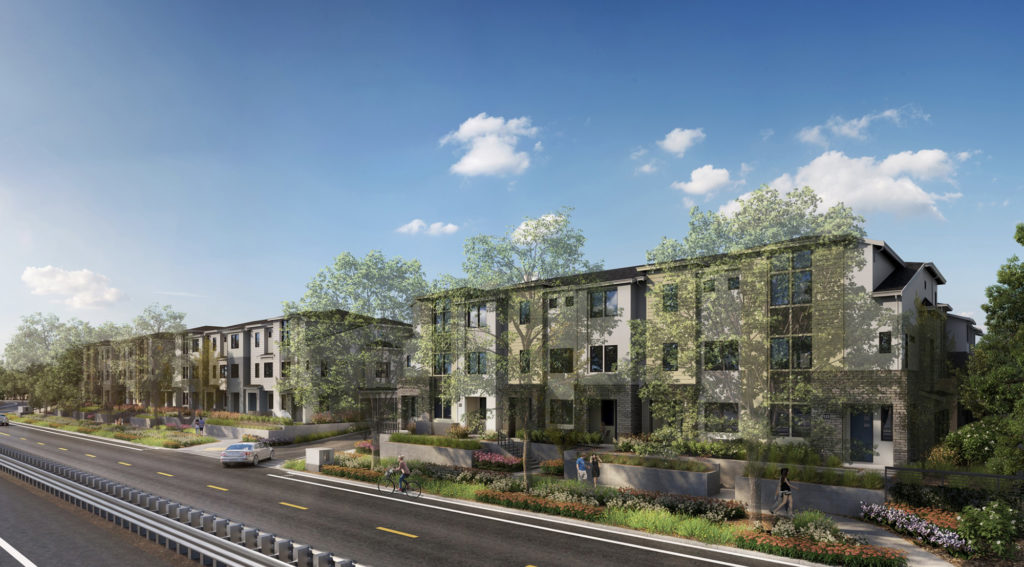[ad_1]
When SummerHill Homes was going through Palo Alto’s architectural review process for its 48-townhome proposal on West Bayshore Road, the city’s chief advisory panel concluded that the project is poorly designed, overly car-centric and fails to meet the city’s standards for “high aesthetic quality.”
None of that seemed to matter on Monday night, when the City Council unanimously voted to approve the development, which will replace a one-story commercial building next to Greer Park. In doing so, council members both acknowledged the merits of the project and recognized their own dwindling powers when it comes to rejecting or modifying residential proposals given new state laws that bar cities from doing so based on the type of subjective criteria that the Architectural Review Board used to recommend denial.
The project at 2850 W. Bayshore Road in many ways epitomized the growing influence of recent legislation of Senate Bill 330 and the Housing Accountability Act, which limits city reviews to five hearings and requires them to rely strictly on “objective criteria” that can be easily measured and is not subject to interpretation when evaluating housing projects. It also demonstrated the waning influence of the context-based standards that the city had traditionally used to review projects.
The council recently addressed the state requirements by revamping the city’s objective standards and adding new rules for everything from roof shapes and window glazing to garage design and porch dimensions. But because the SummerHill Homes project was submitted before these standards became law, the city is prohibited from using them to evaluate this project.
“We can only apply objective standards that are in place at the time of application submittal,” Planning Director Jonathan Lait said at the beginning of the Monday hearing. “Importantly, when we make conditions or suggestions to the project, we need to do so in a way that would not lessen the permitted intensity of housing.”
Two members of the Architectural Review Board, David Hirsch and Peter Baltay, made a case to the council for denying the project or requesting further changes. Hirsch listed the various flaws that the board identified, including its findings that the buildings are not sufficiently differentiated and that the road network in the new development lacks sufficient pedestrian access.
“We need to have high aesthetic quality using high quality integrated materials and appropriate construction. … Everybody agreed these are not adequate buildings the way they are designed. It is reasonable to do a much, much better project,” Hirsch said.
Baltay argued that the development would fall well short of complying with the city’s newly approved objective standards and urged the council to request that SummerHill comply with the new rules, notwithstanding the fact that the city can’t legally force the developer to do so.
“I understand and support efforts to simplify our entitlement process, especially for housing,” Baltay said. “But the streamlining of our standards must not be a free pass for a developer to ignore good residential design and sensible urban planning.”
The council, however, found plenty to like about the new development. The project replaces commercial use with residential development, consistent with the type of land use that the council is trying to encourage. And even though the area lacks public transportation options and the site is next to the freeway, Mayor Pat Burt noted the wealth of biking amenities in the area and the project’s proximity to the city’s new bike bridge over the U.S. Highway 101.
He and other council members also lauded the size of the residences in the new development, which will include 37 three-bedroom units and 11 four-bedroom units, with sizes ranging from 1,600 square feet to 2,100 square feet. This, he noted, stands in large contrast to the majority of the city’s recent development proposals, which typically feature studios and one-bedroom apartments.
“This project is one of the few that we have that is really for families,” Burt said.
Council member Greer Stone noted that seven of the 48 units would be allocated for residents with “low” or “moderate” income levels and argued that the new residential community would represent a clear improvement over what is there today. He also acknowledged the frustrations of the Architectural Review Board but suggested that the project has improved because of the board’s involvement.
“Are there clear flaws?” Stone asked. “The ARB identified those. But my understanding from state law is that we’re precluded from that.”
John Hickey, vice president of development at SummerHill, said the company has made numerous revisions to the project to address the board’s concerns, including adding a new building type for two of the eight buildings, which involved reducing the building size and adding space for landscaping.
“We really did in good faith try to address the comments — the ones that were feasible to address — in our design,” Hickey said. “We appreciated the comments we got and we believe it made the project better.”
The project also received a mixed reaction from the public, with some residents lauding the creation of a new residential community and others expressing concerns about the review process. David Moss, a former member of the Parks and Recreation Commission, was in the former camp. He urged the city to move the project forward.
“Forty-eight units close to parks and schools is a fantastic use of the property,” Moss said.
Winter Dellenbach, however, said she was disappointed by the developer’s failure to make any significant changes to the project after the board’s initial review of the project and requested revisions.
“I was disturbed by that. … Is our city going to simply ignore that?” Dellenbach asked.
[ad_2]
Source link
